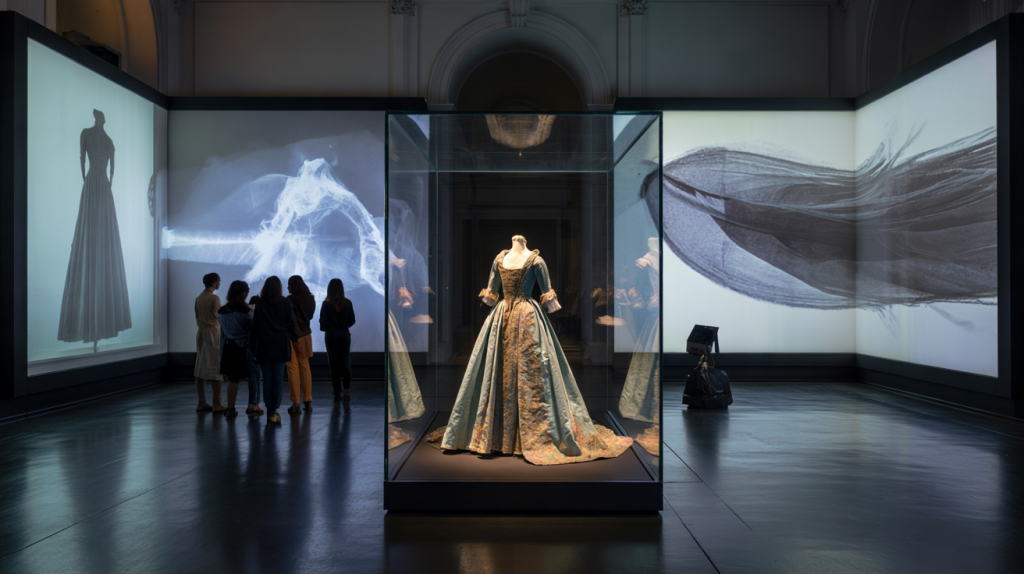Silk rustles, light shifts, and centuries of style feel suddenly alive. The Metropolitan Museum of Art’s Costume Institute turns fashion into experience, not just display, with an exhibition approach that lets visitors see, smell, and literally sense how garments once moved in real life.
In New York, this is the show many plan trips around. The spring 2024 exhibition “Sleeping Beauties : Reawakening Fashion” runs May 10 to September 2, 2024 and assembles about 220 garments and accessories spanning 400 years. Some pieces are too fragile to dress on mannequins, so the galleries use microscopy, scent, animation, and AI to reveal what hands cannot touch. The setup lands squarely on searchers’ intent : what is the Costume Institute showing right now, how ambitious is it, and why does it matter at The Met.
What the Metropolitan Museum of Art Costume Institute delivers
The main idea sits in plain sight. This is costume as cultural record. The Costume Institute cares for a collection that tracks how bodies, power, and craft shaped each other. The current exhibition builds from that mission and solves a common gallery problem : fragile textiles hide their secrets. By translating those hidden layers into light, close video, and even smell, the galleries bring time back into the clothes.
An observation repeats across visitor reactions. Movement tells the story. Trains unfurl on screens, stiffened satins whisper under magnified lenses, embroideries appear and disappear with a tilt of the head. The result sidesteps nostalgia. It explains technique and context with a clarity that reads fast on mobile and in person.
There is also a scale question. How big is the Costume Institute, and why do headlines orbit it each spring. The numbers help. The Met reports the department holds more than 33,000 objects, across five continents and seven centuries. The annual Met Gala launched in 1948 as a fundraiser and today remains the primary source of The Costume Institute’s yearly support. The crowds then follow the show. In 2018, “Heavenly Bodies : Fashion and the Catholic Imagination” drew about 1.65 million visitors across The Met Fifth Avenue and The Met Cloisters, making it the most visited exhibition in the museum’s history.
Key facts and dates that ground the Costume Art story
A few anchors keep the timeline straight. The Museum of Costume Art merged with The Metropolitan Museum of Art in 1946, creating the dedicated department now known as The Costume Institute. After a major renovation, the Anna Wintour Costume Center opened in 2014 as the home base for the collection’s conservation labs and galleries.
The 2024 exhibition “Sleeping Beauties : Reawakening Fashion” places rare, often unworn pieces at its core. The show highlights fragile items sometimes nicknamed “sleeping beauties” that cannot be dressed or handled. Digital animation, x-ray imaging, and scent diffusions help interpret them. The dates matter for planning : May 10 to September 2, 2024, at The Met Fifth Avenue.
Audience appetite shows up in data. The 2015 exhibition “China : Through the Looking Glass” drew more than 800,000 visitors during its run, a watermark that signaled global interest in fashion-as-museum subject. These figures explain the lines at the entrance and why timed arrival becomes smart strategy on weekends.
How to see Costume Art like a pro at The Met
Plenty of visitors hit the galleries and miss the context. A quick plan helps, especially when time is tight or you visit during peak travel months.
- Start early in the day and head straight to the exhibition level before exploring the rest of the museum.
- Scan the object labels out of order when a room feels crowded. The narrative still flows because each section stands alone.
- Watch the short process videos twice. First for the visuals, then for the technique terms that unlock what your eyes just saw.
- Leave 15 minutes for the Anna Wintour Costume Center displays nearby. Conservation notes there clarify why certain garments cannot be dressed.
- If traveling with kids, pick a color or motif scavenger hunt so the group can accomodate slower lookers without stress.
Behind the headlines : the Met Gala link and why the exhibition matters
The sparkle around the first Monday in May has a straightforward function. Publicist Eleanor Lambert started the benefit in 1948 to fund what was then a young collection. That tradition continues. The gala underwrites curatorial research, conservation, and the exhibition calendar that the public sees in the months that follow.
The logic becomes clear when you map cause to effect. Funding supports conservation labs that stabilize centuries-old textiles. Those labs make it possible to safely show rare pieces and to experiment with new interpretation tools. The 2014 opening of the Anna Wintour Costume Center set the infrastructure for that cycle. The 2024 galleries then push it forward with microscopy and digital projections that decode stitch, weave, and wear without exposing garments to damage.
Missing element for many first-time visitors : the rest of The Met reframes the fashion on view. A quick pass through European paintings from the same decades, or Islamic textiles galleries, sharpens how silhouettes and materials traveled across borders. Pairing the Costume Institute with those departments turns a stylish hour into a complete read of the period. That is the quiet secret behind the crowds and the staying power of Costume Art at the Metropolitan Museum of Art.
